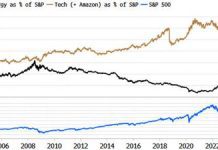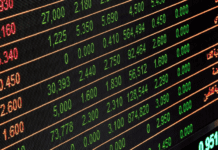The internet has revolutionized not only how we keep up with stocks to watch, thanks to its wealth of up-to-the-minute information, but, also with the act of buying stocks. Once, you needed a trader on Wall Street to buy and sell; now buying stocks online is easily within reach. With some research and a little investment capital, you can buy and sell stocks, too!
Just as with any new industry or field, there’s jargon worth learning to help make buying stocks, whether hot penny stocks or more traditional NASDAQ stocks, easier and less complicated.
Talk like a pro to invest like a pro!
Averaging Down: refers to an investor buying more of a stock as the price goes down so that the average purchase price decreases.
Bear Market: the opposite of a bull market; a bear market means the stock market is in a down trend, or a period of falling stock prices.
Beta: a measurement of the relationship between the price of a stock versus that of the movement of the entire market. For example, if stock A has a beta of 1.5, that means that for every 1 point move in the market, stock A moves 1.5 points as well as the reverse.
Blue Chip Stocks: large, industry leading companies, such as NASDAQ stocks. They offer a stable record of significant dividend payments and have a reputation of sound fiscal management. The expression is thought to have been derived from blue gambling chips, which is the highest denomination of chips used in casinos.
Bull Market: refers to the general stock market in a prolonged period of increasing stock prices; the opposite of a bear market.
Broker: a professional who buys or sells an investment for you in exchange for a fee known as a commission. The benefit of buying stocks online yourself is the freedom to avoid paying this commission.
Day Trading: the practice of buying and selling within the same trading day, meaning before the close of the markets on that business day. Traders that participate in day trading are known as “active traders” or “day traders.”
Dividend: refers to the portion of a company’s earnings paid out to shareholders (aka people owning that company’s stock) on a quarterly or annual basis. Note that not all companies pay out dividends.
Exchange: an exchange is the physical location where different investments are traded. The best known exchanges in the world include: the New York Stock Exchange, the Nasdaq, the Japan Exchange Group, the London Stock Exchange, Shanghai Stock Exchange, and Euronext.
Execution: refers to the completion of an order for selling or buying stocks.
For example, if you put in an order to sell 100 shares, the execution of this order means that all 100 shares have been sold.
Hedge: Perhaps you’ve heard someone use the colloquialism “hedge your bets;” the phrase is often used in mob dramas to mean gambling on more than outcome. Similarly, hedging against investment risk refers to strategically using market instruments to offset the risk of any adverse price movements related to your investment. In other words, savvy traders hedge one investment by making another with negative correlation.
Index: a measurement of a section of the market computed from the prices of select stocks; typically, a weighted average. An index is a benchmark or a tool used to describe the market and to compare the return on specific investments. For example, a 10% return compared to a market index of 12% was not the best investment versus the same 10% return compared to a market index of 8%.
Initial Public Offering (IPO): the very first sale or offering of a stock by a company to the public instead of just its private or inside investors.
Margin: an account allowing a person to borrow money from a broker to purchase an investment. In other words, the difference between the amount of the loan against the price of the securities is known as the margin.
Moving Average: a stock’s average price-per-share during a period of time, often 50 and 200 days.
Order: refers to an investor’s bid to buy or sell stocks or option contracts. One puts in an order to buy or sell 100 shares of stock.
Portfolio: a collection of investments owned by an investor ranging from one to infinite.
Quote: information on a stock’s latest trading price. It can be delayed by 20 minutes unless one is using an actual broker trading platform.
Rally: a rapid increase in the value of the market or the price of a stock.
Sector: a group of stocks to buy that are in the same business, field, or industry; there are 11 stock sectors in total.
Some common examples are the technology sector which includes giants like Apple and Microsoft or the healthcare sector which includes Anthem.
Spread: refers to the difference between the bid price and the ask prices of a stock. In other words, it is the difference between the amount someone is willing to buy it for and the price at which someone is willing to sell it.
Stock Symbol: aka ticker symbol: a unique set of letters assigned to a security for trading purposes. NYSE and AMEX listed stocks have one to three characters whereas Nasdaq stocks have four or five characters. For example, Apple’s stock symbol is AAPL and Microsoft’s is MSFT.
Volatility: refers to the price movements of a stock or the general stock market itself. Highly volatile stocks are ones with extreme daily price movements. Stocks that are thinly traded or have low trading volumes are usually volatile.
Volume: is the number of shares traded during a particular time period, usually a day.
Yield: the measure of the return on an investment received from the payment of a dividend determined by dividing the annual dividend amount by the price paid for the stock. For example, a stock bought for $40 a share which pays a $1.00-per-year dividend has a yield of 2.5%.












